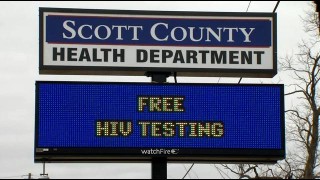
The Indiana HIV epidemic grows worse but to someone who is an outsider to the rural area of Austin, Indiana, it may appear unbelievable that a virus like HIV has taken hold and is devastating such a tiny town. In all honesty, it is extremely shocking to the author of this article, an individual who grew up there, and has history embedded in Indiana from my father’s birth. Yet, it has not turned out to be quite that big a surprise to Sherry McNeely. She is a nurse working at a health care center located in the small town, which has a population of 4,250 individuals.
McNeely explains that it is a common occurrence for her to find confirmation of the epidemic several times a week, which has been connected in part to rampant drug use, in the form of unwanted needles. This is what addicts have been using to shoot up illegal drugs. She states that the problem has been growing for a while now and that she finds the needles along streets “all the time.” Sherry also added that it is not uncommon for people to discover dirty needles at one of the town’s playgrounds.
McNeely was just one of numerous staff members at Austin’s health clinic who were providing interviews for local, state and national media channels as the many outlets came into the rural town to report on the events happening and also write about the medical center’s brand new mobile HIV unit, where Austin’s residents can now go and be tested for the deadly virus for free.
The unit coming into the town was organized by Dr. William Cooke, the only doctor in Austin. It has also helped push the rural area into nationwide limelight due to it being part of a bigger policy debate. Indiana Governor Mike Pence has decided to declare a public health emergency for Austin and the entire county in which the town in located, Scott County. In doing so, it has brought about a coast-to-coast conversation about public health and HIV.
Yet, the small town has also become the focus of a medical mystery. Why is HIV here in such staggering numbers? What is making it so different from other comparable rural towns across the United States? When people look at Austin, it really does not look that much different from other small towns located in the Midwest. It is fairly quiet and appears as if time has left it behind for the most part. The one grocery store the town had is now closed up and there is only one four way stoplight.
There are no well-known fast food restaurant chains located in town except for an outdated Dairy Queen where individuals are only able to order from the outside. There is one liquor store near the stoplight. However, the irony abounds when one notices that there are numerous churches in town.
Yet, Austin’s rampant HIV problems are new and have stunned those looking on from the outside. Since December, HIV cases have been on the rise and now there are close to 90 confirmed cases in Scott County. The majority have come to light over the past couple of months. Almost all of the present cases appear to include the drug users shooting up the drug Opana. It is a variety of the potent painkiller oxymorphone.
However, dirty needles from drug abuse is not the only reason for the HIV outbreak. Austin also has major problems with lingering poverty and unsafe sex practices. Even though the precise numbers are not known, town officials explain that prostitutes and their customers have played a major role in the spread of HIV in Austin. The illegal sex trade has been a major issue for years in the small town.
A retired construction worker who wants to remain anonymous, but who resides in Austin, states that the women who perform as prostitutes have sex for money even though they are diagnosed with the HIV virus. The upset retiree said, “They know they have HIV but because they are drug addicts and want to get high, they still go out and have sex for money. I saw a couple just today. It makes me really mad.”
Dr. Ruth Carrico, an associate professor at the University of Louisville, located in nearby Kentucky, states that prostitution is intensifying the HIV problem in Austin but adds that there are other problems as well. She explains that drug abusers tend to stick close as a group. Their social habits cause them to stay together and rely on each other for various needs and support. Because of this, when HIV somehow comes into the picture, the epidemic explodes.
However, people still wonder what caused the HIV problem to happen in Austin in the first place. There are plenty of small towns that have illegal drug use and prostitution going on. What did Austin do to have the time bomb go off? Some individuals believe that there were possibly individuals who arrived from out of town such as Chicago or other large cities who were infected from advanced HIV and started spreading the virus to other drug users who were also using the same needles or through unsafe sex. People who participate in either or both of these two activities are the ones who are most at risk for HIV, so if the virus enters into either of these groups, the amount of individuals who may contract it can go through the ceiling.
Even though Austin is the center of attention at the moment, it is hardly the only community that is facing the HIV epidemic risk. HIV is a problem all over the world, not just in one small town in southern Indiana.
